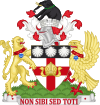Coat of arms of the London Borough of Camden
| Coat of arms of the London Borough of Camden | ||
|---|---|---|
Shield Argent on a Cross Gules a Mitre Or a Chief Sable thereon three Escallops Argent. | | |
| Supporters | On the dexter side a Lion and on the sinister side a Eagle Or each gorged with a Collar the dexter Argent charged with three Mullets Sable the sinister Gules charged with three Mullets Or and pendent from the collar of each a Fountain. | |
| Compartment | A grassy mound vert | |
| Motto | Latin: *NON SIBI SED TOTI* (Not for self but for all) | |

The coat of arms of the London Borough of Camden were granted on 10 September 1965. The borough was formed by the merger of three former boroughs, namely the Metropolitan Borough of Hampstead, the Metropolitan Borough of Holborn and the Metropolitan Borough of St. Pancras, from whose arms elements were utilised in the arms of the new borough.
Arms
The arms of the London Borough of Camden are
Crest
The crest is: On a wreath of the colours issuant from a mural crown argent a demi-elephant sable armed or about the neck a wreath of holly fructed proper. The mural crown is a common heraldic symbol for local municipal authorities and in these arms it is also a reminder that Camden is adjacent to the old city wall of the City of London. The elephant is taken from the arms of the Pratt family, as Camden Town is named after Charles Pratt, 1st Earl Camden (1713–1794), father of John Pratt, 1st Marquess Camden (1759–1840). An elephant is also present in the coat of arms of St. Pancras, but the wreath of holly around its neck in the crest of the Borough of Camden is taken from the coat of arms of Hampstead, itself taken from the seal of the vestry in Hampstead.
Supporters
The supporters are: On the dexter side a lion and on the sinister side a eagle or each gorged with a collar the dexter argent charged with three mullets sable the sinister gules charged with three mullets or and pendent from the collar of each a fountain. They are derived from the arms of
Motto
The motto, NON SIBI SED TOTI, is Latin for 'not for self but for all' and was previously used by Holborn.[1][2]
Badge
The


